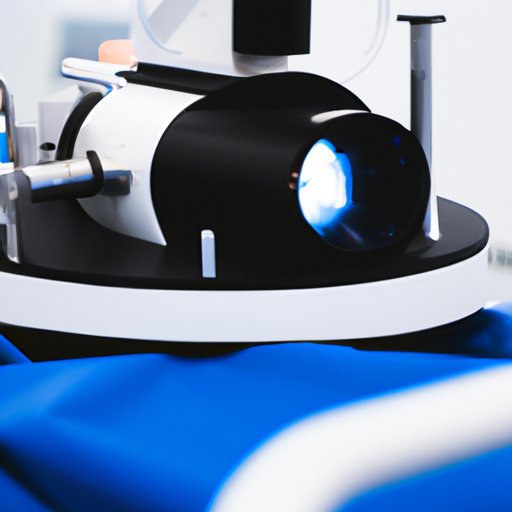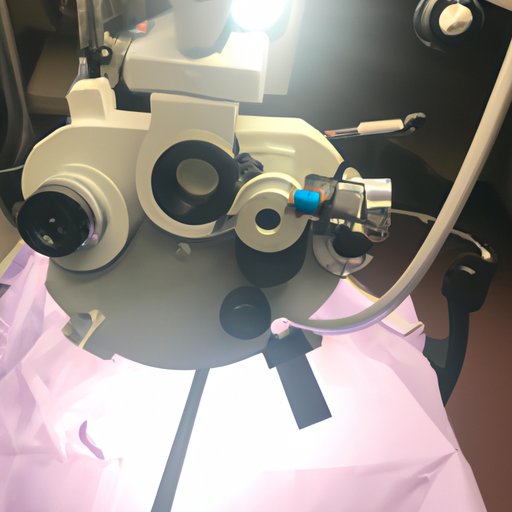Introduction
LASIK (Laser Assisted In Situ Keratomileusis) is a type of corrective eye surgery that has become increasingly popular over the past few decades. The procedure is designed to correct vision problems such as nearsightedness (myopia), farsightedness (hyperopia) and astigmatism. It works by using laser technology to reshape the cornea, which is the front part of the eye. The reshaped cornea then serves to refocus light rays entering the eye, resulting in improved vision.

Exploring the Science Behind How LASIK Eye Surgery Works
LASIK eye surgery is performed using a specialized laser called an excimer laser. This laser is able to precisely remove microscopic amounts of tissue from the cornea without damaging surrounding tissues. During the procedure, the surgeon will create a flap in the cornea and then use the laser to reshape the underlying tissue. This reshaping of the cornea helps to change its curvature, allowing light rays to be more accurately focused on the retina.
Although the procedure is generally safe, there are some potential risks associated with LASIK eye surgery. These include infection, dry eyes, and vision disturbances such as halos, starbursts, or double vision. It is important to speak to an experienced ophthalmologist before undergoing the procedure in order to understand all of the possible risks and benefits.

An Inside Look at How LASIK Surgery is Performed
The actual procedure typically takes around 15 minutes per eye. Before the procedure begins, the patient will receive a comprehensive preoperative assessment to determine if they are suitable for the procedure. During the assessment, the doctor will check the patient’s vision and the shape and thickness of their cornea. The patient may also be asked to fill out a questionnaire about their general health and lifestyle.
Once the assessment is complete, the patient will receive either topical or local anesthesia. Depending on the type of anesthesia used, the patient may remain awake during the procedure. Once the patient is ready, the surgeon will use a femtosecond laser to create a small flap in the cornea. Then, the excimer laser will be used to reshape the underlying corneal tissue. After the surgery is complete, the flap will be replaced and the patient will be given instructions for postoperative care.
A Step-by-Step Guide to Understanding LASIK Procedures
Below is a step-by-step guide to understanding how LASIK eye surgery works:
- Preoperative Assessment: A comprehensive eye exam is conducted to determine if the patient is suitable for the procedure.
- Anesthesia: Depending on the type of anesthesia used, the patient may remain awake during the procedure.
- Creating the Flap: A femtosecond laser is used to create a small flap in the cornea.
- Reshaping the Cornea: An excimer laser is used to reshape the underlying corneal tissue.
- Postoperative Care: The patient will be instructed on how to properly care for their eyes after the procedure.
A Comprehensive Overview of LASIK Technology and Its Benefits
One of the main advantages of LASIK eye surgery is that it can provide long-term results. Studies have shown that the majority of patients who undergo the procedure are able to achieve 20/20 vision or better. Additionally, the procedure can be used to treat a variety of vision problems, including presbyopia and astigmatism. The technology can also be used to treat other vision problems, such as cataracts and glaucoma.
LASIK eye surgery is also relatively quick and painless. Most procedures take less than 15 minutes per eye, and the recovery time is usually very short. Patients may experience some discomfort after the procedure, but this should subside quickly. Additionally, most patients are able to return to their normal activities within a few days.

Unpacking the Risks and Benefits of LASIK Eye Surgery
Although the procedure is generally safe, there are some potential risks associated with LASIK eye surgery. These include infection, dry eyes, and vision disturbances such as halos, starbursts, or double vision. Additionally, the procedure is not recommended for people with certain medical conditions, such as diabetes, auto-immune diseases, or chronic dry eyes. Therefore, it is important to speak to an experienced ophthalmologist before undergoing the procedure in order to understand all of the possible risks and benefits.
In terms of cost, the price of LASIK eye surgery varies depending on the complexity of the procedure and the technology used. However, it is generally less expensive than other types of corrective eye surgery, such as PRK or phakic IOLs. Additionally, many insurance plans cover at least a portion of the cost of LASIK eye surgery.
Conclusion
LASIK eye surgery is a safe and effective way to correct vision problems such as nearsightedness, farsightedness, and astigmatism. The procedure uses laser technology to reshape the cornea, resulting in improved vision. Although there are some potential risks associated with the procedure, the majority of patients are able to achieve 20/20 vision or better with no complications. Additionally, the cost of the procedure is generally less expensive than other types of corrective eye surgery.
If you are considering undergoing LASIK eye surgery, it is important to speak to an experienced ophthalmologist to understand all of the possible risks and benefits. With the right information, you can make an informed decision about whether or not the procedure is right for you.
(Note: Is this article not meeting your expectations? Do you have knowledge or insights to share? Unlock new opportunities and expand your reach by joining our authors team. Click Registration to join us and share your expertise with our readers.)
